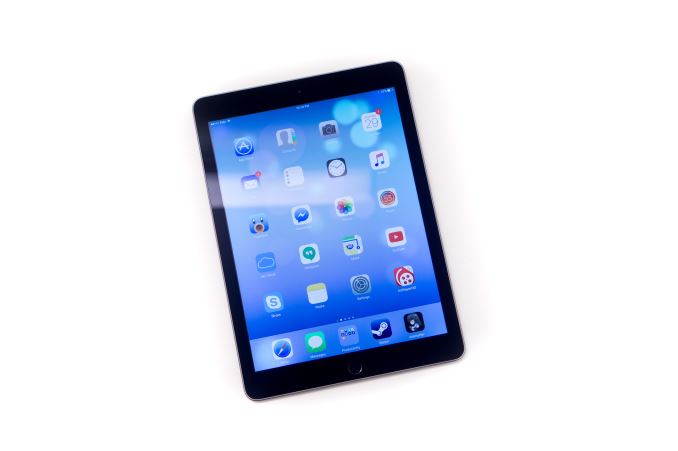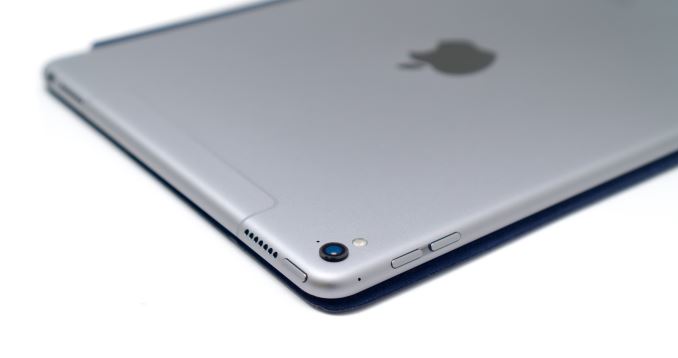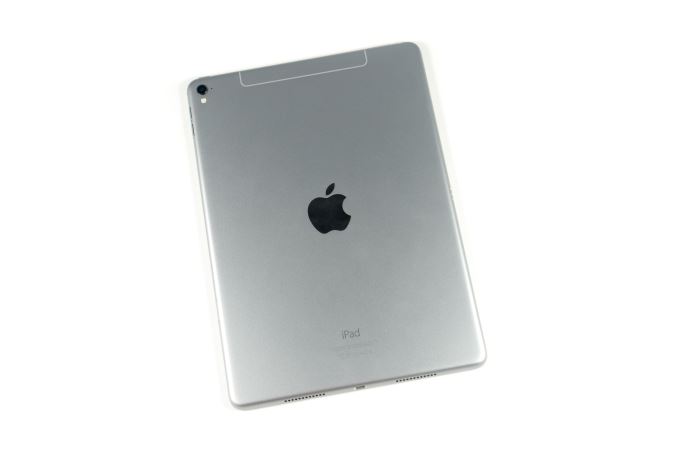The 9.7" iPad Pro Review
by Brandon Chester on June 1, 2016 9:00 AM EST
In late 2015 Apple launched a tablet that they called the iPad Pro. It had been rumored for quite some time, and it had a number of features that differentiated it from other iPads. The most notable was its 12.9" display, which has a width equal to the height of Apple's 9.7" iPads, allowing it to use two essentially full sized iPad applications at the same time in a split screen view. In addition to its massive display, the iPad Pro came with two accessories that had not existed for any prior iPad. It seemed that in Apple's eyes the Apple Pencil and the Smart Keyboard really defined what made the iPad Pro worthy of the "Pro" name.
Meanwhile, the launch of the iPad Pro came and went, and there was no news of a successor to Apple's iPad Air 2, which had just turned one year old. I thought that this move may have had to do with Apple not facing much competition in the tablet market. On the other hand, with iPad sales down it wouldn't generate much excitement to keep selling the same tablet for a second year.
After the launch of the iPad Pro the rumor mill continued to churn out new info, and there were whispers of a so called "iPad Air 3" coming in early 2016. Later, the story became that Apple was actually planning another iPad Pro to take the place of the iPad Air 2 as Apple's flagship 9.7" iPad. In the end it turned out that Apple did exactly that, and along with bringing the specs of the larger iPad Pro to a smaller size, the smaller iPad Pro comes with some surprises of its own. Below you can view the current state of the iPad line now that Apple has two devices called the iPad Pro.
| Apple iPad Family | |||
|
|
Apple iPad Air 2 | Apple iPad Pro 9.7" | Apple iPad Pro 12.9" |
| SoC | Apple A8X 3 x Apple Typhoon @ 1.5GHz |
Apple A9X 2 x Apple Twister @ ~2.2GHz |
Apple A9X 2 x Apple Twister @ ~2.2GHz |
| GPU | PowerVR 8 Cluster Series6XT | PowerVR 12 Cluster Series7XT | |
| RAM | 2GB LPDDR3 | 2GB LPDDR4 | 4GB LPDDR4 |
| NAND | 16/64/128 GB | WiFi: 32 / 128 / 256 GB | |
| WiFi + Cellular: 32 / 128 / 256 GB |
WiFi + Cellular: 128 / 256 GB |
||
| Display | 9.7" 2048x1536 IPS LCD | 12.9" 2732x2048 IPS LCD | |
| Gamut | sRGB | DCI-P3 | sRGB |
| Size and Mass | 240 x 169.5 x 6.1mm 437g WiFi, 444g LTE |
305.7 x 220.6 x 6.9 mm 713g WiFi, 723g LTE |
|
| Camera | 8MP Rear-facing f/2.4, 1.1 micron |
12MP Rear-facing f/2.2, 1.22 micron |
8MP Rear-facing f/2.4, 1.1 micron |
| 1.2MP Front-facing f/2.2 | 5MP Front-facing f/2.2 | 1.2MP Front-facing f/2.2 | |
| Battery | 27.3 Wh | 27.5 Wh | 38.5 Wh |
| Launch OS | iOS 8 | iOS 9 | |
| Cellular | Category 4 LTE + GPS/GNSS in Cellular SKU | ||
| Other Connectivity | 2x2 802.11a/b/g/n/ac + BT 4.2, Apple Lightning, Smart Connector on iPad Pro | ||
| SIM | Optional NanoSIM | ||
| Current Price |
16GB: $399 |
32 GB: $599 128 GB: $749 256 GB: $899 |
32 GB: $799 128 GB: $949 256 GB: $1079 (LTE) |
The 9.7” iPad Pro has the same core industrial design that Apple’s iPads have used since the launch of the iPad Air. The back is almost entirely flat, curving up quickly near the edges and meeting the cover glass with a shiny chamfered edge. Like the 12.9” model, the 9.7” iPad Pro changes things up by moving to a four-speaker audio setup, which requires holes drilled on both the top and bottom of the chassis. Interestingly, the 9.7” iPad Pro uses asymmetrical speaker grilles, with the bottom two being larger than those of the 12.9” model, and the top being smaller. This is likely due to the more constrained space inside the chassis. As for the speakers themselves, the audio quality did seem to be a step down from the larger iPad Pro, but it’s still miles ahead of anything else that I’ve seen on a tablet of this size and a significant improvement from the iPad Air 2.
The 9.7” iPad also comes with some changes of its own. The camera now has a hump, which will undoubtedly upset those who focus heavily on the uniformity of the design. There was no good way to improve upon the iPad Air 2’s camera within a 6.1mm chassis without putting a hump, and as we’ll see later, the camera in this iPad Pro is a huge improvement over Apple’s other iPads. While the hump is there, with such a large chassis the angle it makes with a flat surface is so small that the tablet doesn’t rock back and forth when using it on a table, which is extremely important to ensure the usability of the Apple Pencil.
Apple has also changed up the antenna design. Going back to the first iPads, the cellular models have sported a plastic RF window at the top of the chassis to allow for RF propagation. With the 9.7” iPad Pro, Apple adopts a similar antenna design to that of the iPhone 6 and 6s, where the top now has a metal segment for the antenna with insulating plastic lines surrounding it.
I think this is a significant upgrade to the design of the cellular model for a couple of reasons. Aesthetically it simply looks better, as the plastic inserts weren’t color matched and so they stood out from the rest of the aluminum back cover. They also weren’t always aligned perfectly, and so at the edge between the plastic and the aluminum you could feel a noticeable seam due to the plastic being either at a higher or lower level than the chassis. The new antenna design eliminates both of these issues, and brings the 9.7” iPad Pro as close as it can get to an unbroken aluminum unibody when also having to support cellular networking.
Beyond the changes with the camera, speakers, and antenna on the cellular model, the 9.7” iPad Pro has the same design as the iPad Air 2. They share the same mass and dimensions, and as I mentioned before the core ID is the same. Whether or not Apple could improve upon the design further is up for debate, but they don’t really have any true competition in this space and so they’ve been able to maintain their design lead by making iterative improvements on the original iPad Air design. That design still works very well, and so I don’t see much reason to change things up significantly just for the sake of saying you have a new design.












144 Comments
View All Comments
ragingfighter - Wednesday, July 13, 2016 - link
If $1000 for a tablet is something you could afford that's fine but keep in mind $1000 can get you a good laptop as well I don't not your choice and this is not a criticism to what you chose for your workflow so I don't want you to take it as such it's just a general opinion.syxbit - Wednesday, June 1, 2016 - link
Google should be ashamed of themselves with those internal NAND (sequential write) results. The iPad is 10x the performance of the Pixel C...Wolfpup - Wednesday, June 1, 2016 - link
I wonder if that's with encryption on or off? I sure hope that's with it on :-OI love that iOS just comes with it on now, and users don't need to know anything, manage it, etc., NOR worry about performance.
I know my Android tablet was seriously dirt slow...well, dirt slow in general, and in storage performance specifically. (What blew me away was my equivalently speced Surface running close-to-full-Windows ran circles around it...which is like WHAAAAAT, the limited mobile OS is supposed to at least be faster LOL)
grayson_carr - Thursday, June 2, 2016 - link
New Android devices all come with encryption on as well. And while Apple does hold a huge lead in NAND performance, I haven't noticed the storage performance of Android devices negatively impacting day to day use since the Nexus 6.ragingfighter - Wednesday, July 13, 2016 - link
I think it's the cost of having a filesystem a more Advanced interaction with it all and having the full on options of tweaking and placement and so on that also can bog down an operating system. A lot of how we perceive a ui or user interface or operating system is in which the speed and workflow comes across such as finding what you're trying to work on how fast it comes on screen how much time you save. With iOS, either not have a file system as you just have apps apps that do specific things. Depending on what type of workflow you have this can be easier or harder you do not have to look through a lot of submenus to find a file or something you're working on. Is your work something that you can transferred to the cloud and just so you have access to other devices after it's done or do you work on a tablet at home and have a come up on your computer at work?When you start getting into the sub areas of an operating system terminal command lines and all types of other advanced features and code and stuff that is one in a way I believe the operating system gets perceived as cluttered. Even something as simple as removing programs and just drag them to the garbage can for being deleted is something common sense and I was amazed that is not implemented across all operating systems. The complexity of having to go to your ad and remove programs list on windows to delete something still is amazing to me that people would have to do such a thing for such a basic function Especially during the year 2016. The thing that makes iOS really good is also the same thing that makes it really bad for some and that is its basic simplicity iOS is at its greatest for young children for people that have a writing type of workflow for consumption, but especially for the elderly that do not have as much technical know-how as others have in life I know I have relatives that if it wasn't for the iPad they would still be thinking of 56K not know how to check their emails and truly enjoy the web. They are not great typists not nearly there not know what the Home row is. In this regard voice dictation gives them another way to interact with their tablets which are computers and allows them to use them much better than without.
Hemlocke - Thursday, June 2, 2016 - link
It shows in daily usage, too. My Pixel C went out the door to get my Pro 9.7, and after a few hours, I know I made the right choice. The Pixel was irritating, with hiccups and stutters when there is no reason for it. My Air 2 was a better tablet.lucam - Wednesday, June 1, 2016 - link
Hi Brandon,There is the new GFX Bench 3.1 available for IOS too; especially the new one 1440 resolution.
It's worth trying it.
Oyeve - Wednesday, June 1, 2016 - link
Would be nice if you actually FINISHED your S7 review to see those pic samples against this tablet. I own the 9.7 pro and the S7 and the S7 just blows the pro away. Hmmm, thats probably why you guys never finished the S7 review. It would crush your apple love.Brandon Chester - Wednesday, June 1, 2016 - link
I stated in the article that the sensor used in the 6s/SE/9.7" is not the best sensor in a smartphone. I would argue that the Galaxy S6 is superior, let alone 2016's Android devices. Your perception of bias is unfounded.KPOM - Wednesday, June 1, 2016 - link
Apple haters gonna hate. For whatever reason they can't accept a decent review of an Apple product, even one that points out its flaws.I like AT and am glad the new ownership doesn't seem to have affected its editorial independence. Kudos to Ryan and the whole team.